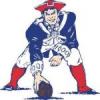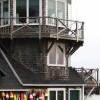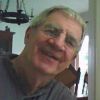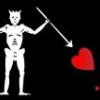
JerseyCity Frankie
-
Posts
1,338 -
Joined
-
Last visited
Reputation Activity
-
 JerseyCity Frankie got a reaction from SkerryAmp in Everyone's paint preference
JerseyCity Frankie got a reaction from SkerryAmp in Everyone's paint preference
I too want to put in a word for "artist" acrylic paint. In tubes or in small jars, manufactured by Golden, Liquitex or whatever. All of them are water based and can be mixed with other brands. Full strength or thinned to nearly nothing at all, acrylic can be anything from a stain to an thick opaque coating. Water is all you need to thin or clean up. The paint dries as fast as water dries and when its dry its no longer water soluble and will stand up to U.V. light, changing humidity and who knows what else? Acrylic artists paint is available in nearly any size, from a very small tube the size of your pinkie on up to gallons, and in every color. Its possible to find "student grade" acrylic colors and these will have a "hamburger helper" dumbed down pigment content but the artist grade paint will contain the best sorts of pigments available anywhere and the pigment content is listed on the container- something I suspect other hobby paints won't do for you. Note that the use of the finest pigments includes poisonous ones like cobalt and cadmium which should NEVER be used with a sprayer. Sometimes the "student grade" colors are better for what you have in mind and they cost about 1/3 less than the Artist Grade ones. You can't use Acrylic over unprimed metal though, nor any sort of smooth ceramic like surface. But it will stick fairly well to plastic. The shelf life of the paint is pretty good. If you leave a tube of acrylic paint sealed it will still be fine a year later.
-
 JerseyCity Frankie got a reaction from trippwj in Gaff halyard rigging: one line or two
JerseyCity Frankie got a reaction from trippwj in Gaff halyard rigging: one line or two
I'm not familiar with the vessel in question but here are my two cents. The reason for more than one peak halyard would be to make the job of setting the sail easier or faster. On paper, one line can be used to do the job of raising the peak on any fore and aft sail but in practice you have to factor in the impact on the crew. If the sail is large enough your single line has to be made of stouter rope and the physical effort in raising sail becomes problematic. I don't know at what point a double peak halyard would come in but I can tell you from my direct experience on a 102' and a 125' schooner that there was only one line on each peak and a group of four or five people could handle it on the smaller 102' schooner, all hands on the larger. The Throats too. Incidentally you need separate peak and throat lines. It would be possible to rig one line to do all the work but it would rob you of sail handling options. Underway, one person can take all the horsepower out of the sail by simply easing the peak a bit, this makes the peak of the sail droop down enough to ruin the sails aerodynamic effect and doing this can give the helmsman more options for maneuvering in certain situations. Its also useful to be able to change the gaff angle when you are furling the sail, when you lower the gaff to the deck the angle of the gaff as it comes down has a huge effect on how the sail is gathered and folded for stowing.
-
 JerseyCity Frankie reacted to Mike 41 in USS Pennsylvania 1837 by Mike 41 - Scale: 1:64 - Cross-Section
JerseyCity Frankie reacted to Mike 41 in USS Pennsylvania 1837 by Mike 41 - Scale: 1:64 - Cross-Section
The orlop deck planking is European beech wood and is shown on the starboard side the port side will be left open to show the framing on all the decks.
-
 JerseyCity Frankie got a reaction from Elia in TO PAINT OR NOT TO PAINT (Moved by moderator)
JerseyCity Frankie got a reaction from Elia in TO PAINT OR NOT TO PAINT (Moved by moderator)
Wooden ship kit manufacturers seldom show a painted completed model on the kits box art. I think this practice has instilled the idea in some people’s heads that the finished kit should be left unpainted. I think the kit manufacturers actual intentions though are only to clearly depict the different materials provided in the kit and a painted model would disguise the different species of wood or white metal or brass parts the kit features. This aside, there is a lot to be said for the practice of leaving a model unpainted that has nothing to do with how kits are marketed. Demonstrating to the viewer a models true nature is best done without covering anything with paint. For instance it would make no sense at all to paint a bone model. On the other hand I don’t think any serious plastic kit model builders ever leave any part of a finished plastic kit unpainted, their goal is to produce something that “looks like the real thing”, not to “demonstrate the true nature” of the styrene plastic the kit was made of. So I think the intentions of the builder dictate weather or not to use paint. I will point out though that there were no unpainted ships sailing the world’s oceans. Every exterior surface on a wooden ship was painted tarred oiled or varnished in one way or another in order to protect the ship from the elements and any wooden vessel that didn’t get some sort of surface coating would quickly be reduced to driftwood by the marine environment.
-
 JerseyCity Frankie got a reaction from Script in Ratlines....why so important.....
JerseyCity Frankie got a reaction from Script in Ratlines....why so important.....
I was VERY SURPRISED to learn recently, here on M.S.W., that there were at one point in the past New York City Pilot Schooners that had no ratlines on their shrouds. Presumably to make them that much faster? I couldn't then and still can't fathom how they would have been able to manage things without them. Sure they could use a boatswains chair for getting aloft and maybe they even had crew aboard who were so extraordinarily fit that they could go aloft arm over arm on the naked shrouds? But I still can't understand what, if anything, was gained by omitting ratlines. A tiny bit less windage? an infinitesimal lowering of the center of gravity?
-
 JerseyCity Frankie reacted to Mirabell61 in How to sew sails on your wifes sewing machine
JerseyCity Frankie reacted to Mirabell61 in How to sew sails on your wifes sewing machine
Part 2
have to push through... "Pamir" takes 32 sails and "Gorch Fock" 23 sails
textile glue with fine applicartion nozzle, works surprisingly well (found on Ebay)
this is a spool of 0,5mm Polyester weaved hollow thread. Predestinated for pushing a wire Soul through, works well !
full suit sails mounted, my Tallship "Pamir" model
likewise, sails attached to "Gorch Fock"
Nils
-
 JerseyCity Frankie got a reaction from riverboat in TO PAINT OR NOT TO PAINT (Moved by moderator)
JerseyCity Frankie got a reaction from riverboat in TO PAINT OR NOT TO PAINT (Moved by moderator)
Wooden ship kit manufacturers seldom show a painted completed model on the kits box art. I think this practice has instilled the idea in some people’s heads that the finished kit should be left unpainted. I think the kit manufacturers actual intentions though are only to clearly depict the different materials provided in the kit and a painted model would disguise the different species of wood or white metal or brass parts the kit features. This aside, there is a lot to be said for the practice of leaving a model unpainted that has nothing to do with how kits are marketed. Demonstrating to the viewer a models true nature is best done without covering anything with paint. For instance it would make no sense at all to paint a bone model. On the other hand I don’t think any serious plastic kit model builders ever leave any part of a finished plastic kit unpainted, their goal is to produce something that “looks like the real thing”, not to “demonstrate the true nature” of the styrene plastic the kit was made of. So I think the intentions of the builder dictate weather or not to use paint. I will point out though that there were no unpainted ships sailing the world’s oceans. Every exterior surface on a wooden ship was painted tarred oiled or varnished in one way or another in order to protect the ship from the elements and any wooden vessel that didn’t get some sort of surface coating would quickly be reduced to driftwood by the marine environment.
-
 JerseyCity Frankie reacted to dafi in HMS Victory by dafi - Heller - PLASTIC - To Victory and beyond ...
JerseyCity Frankie reacted to dafi in HMS Victory by dafi - Heller - PLASTIC - To Victory and beyond ...
So the pot is empty ...
... time to do something more important and worthy ...
... as both scuttles for the vent trunks were mere black holes. So they got their wooden cases and look much more in tune now :-)
And here some fresh impressions from the shipyard.
Good night, Daniel -
 JerseyCity Frankie reacted to guillemot in Scottish Maid by guillemot - FINISHED - 1/8" scale - Hall's 1839 Clipper Schooner
JerseyCity Frankie reacted to guillemot in Scottish Maid by guillemot - FINISHED - 1/8" scale - Hall's 1839 Clipper Schooner
Rainy day, I thought some indoor tasks would be just the thing, so I've started carving the sea base. I have some new Flexcut chisels on order but they'll be another few days so I had a shot at resharpening the two old gouges I have. Gouges are a total sod to sharpen but I got them to a reasonably servicable state. This is the result so far, lots more wood to be removed. I'm considering training a beaver...
The hole for the model is oversize to allow setting it in at an angle and the spare space around the edge will be filled in with milliput - white.
Christian, Good luck with Diligent, she really had an extreme hull form! Scottish Maid, of course comes from a rather different tradition, and really isn't related at all to the Baltimore ships. Of the Baltimore Clippers, I have a 'Fair Rosamund' under construction and the one I'd really like to do would be 'Grecian'.
-
 JerseyCity Frankie got a reaction from DSiemens in The Kraken by JerseyCity Frankie - BOTTLE
JerseyCity Frankie got a reaction from DSiemens in The Kraken by JerseyCity Frankie - BOTTLE
Dan I suppose Ralph Preston got to be one of the top U.S. ship-in-a-bottle modelers by pulling a few strings......
-
 JerseyCity Frankie got a reaction from IgorSky in The Kraken by JerseyCity Frankie - BOTTLE
JerseyCity Frankie got a reaction from IgorSky in The Kraken by JerseyCity Frankie - BOTTLE
With the water in place and the wooden base built, the ship itself constructed and painted and now a new useful tool to use I guess there is no excuse but to proceed with getting the Kraken inside the bottle.
-
 JerseyCity Frankie got a reaction from Farbror Fartyg in The Kraken by JerseyCity Frankie - BOTTLE
JerseyCity Frankie got a reaction from Farbror Fartyg in The Kraken by JerseyCity Frankie - BOTTLE
With the water in place and the wooden base built, the ship itself constructed and painted and now a new useful tool to use I guess there is no excuse but to proceed with getting the Kraken inside the bottle.
-
 JerseyCity Frankie reacted to Remcohe in HMS Kingfisher 1770 by Remcohe - 1/48 - English 14-Gun Sloop - POF
JerseyCity Frankie reacted to Remcohe in HMS Kingfisher 1770 by Remcohe - 1/48 - English 14-Gun Sloop - POF
I got fed up with the plastic kit and it served it's purpose, I back working on my KF.
Shaping the parts at the bow is a little tricky but fun especially with the scarph joints and the mast partner that has it's carlings cut from the onder side of the beam. Partially fixed partially test fitted here's the progress to date. Having the fore mast finished already helps to align all parts.
Nils, thank you. Indeed the frame work is close to the real thing but not completely. I did not make the chokes as separate parts but they are part of the frame timbers.
Remco
-
 JerseyCity Frankie got a reaction from IgorSky in The Kraken by JerseyCity Frankie - BOTTLE
JerseyCity Frankie got a reaction from IgorSky in The Kraken by JerseyCity Frankie - BOTTLE
Making tools to get at stuff on the inside of the bottle need not be a huge challenge if you select a bottle with the right ratio of neck diameter to neck width. The inside diameter of the bottle also plays a roll and some geometries won’t allow you to have an influence anywhere inside the bottle. Usually you don’t need anything more than a bit of wire twisted over the end of a wooden dowel or bamboo skewer and up till now I had not needed to build special tools more complex than a piece of razor blade attached to a stick. But this project has had some special challenges. This tool is simply a tweezers tied to a threaded rod. I use metal rod since the leverage you put onto the end of the tool that you can grasp has a strong effect within the bottle and wood can break or bend more often than you would think.
-
 JerseyCity Frankie got a reaction from qwerty2008 in The Kraken by JerseyCity Frankie - BOTTLE
JerseyCity Frankie got a reaction from qwerty2008 in The Kraken by JerseyCity Frankie - BOTTLE
Here is the tool in use within the bottle. Its holding a cotton swab dipped in rubbing alcohol and its making short work of the glommed on clay residue at the “water line”. The tool with the tweezers on the end could not reach the waters edge and when I tried to hold a Q-tip and use that to swab the inside it simply wasn't effective.
-
 JerseyCity Frankie got a reaction from mtaylor in The Kraken by JerseyCity Frankie - BOTTLE
JerseyCity Frankie got a reaction from mtaylor in The Kraken by JerseyCity Frankie - BOTTLE
With the water in place and the wooden base built, the ship itself constructed and painted and now a new useful tool to use I guess there is no excuse but to proceed with getting the Kraken inside the bottle.
-
 JerseyCity Frankie reacted to shipmodel in The Kraken by JerseyCity Frankie - BOTTLE
JerseyCity Frankie reacted to shipmodel in The Kraken by JerseyCity Frankie - BOTTLE
Nice save with the new tool. When I saw the first photo I could not imagine how you were going to get the clay removed from the inside walls of the bottle. There are some intricate tools developed by Ralph Preston for bottling models that you can read in Ship Modelers' Shop Notes II from the Nautical Research Guild. The articles may give you some ideas. Ralph is one of the top ship-in-a-bottle modelers in the US.
Dan
-
 JerseyCity Frankie got a reaction from SailorGreg in The Kraken by JerseyCity Frankie - BOTTLE
JerseyCity Frankie got a reaction from SailorGreg in The Kraken by JerseyCity Frankie - BOTTLE
Here is the tool in use within the bottle. Its holding a cotton swab dipped in rubbing alcohol and its making short work of the glommed on clay residue at the “water line”. The tool with the tweezers on the end could not reach the waters edge and when I tried to hold a Q-tip and use that to swab the inside it simply wasn't effective.
-
 JerseyCity Frankie got a reaction from IgorSky in The Kraken by JerseyCity Frankie - BOTTLE
JerseyCity Frankie got a reaction from IgorSky in The Kraken by JerseyCity Frankie - BOTTLE
I had hoped to avoid building an articulated tool but it has become apparent that with all those tentacles I will have to manipulate I was going to have to make something I could bend around inside the bottle. It turns out it was very easy to make this elbow tool and I was done and using it a lot sooner than I imagined, I had set aside the whole night to cobble something together and really all I had to do was drill a hole and bend some wire. There is no glue or solder in use here at all its just bent wire and knots on the string. The inset photo is the tool in its bent mode. It swings through 120 degrees roughly when I pull on one string and ease the other. I’m sure anyone reading this could build one of these and a lot of you could build a more elegant tool, based on some of the build logs and evident competence I see on this site.
-
 JerseyCity Frankie got a reaction from DSiemens in The Kraken by JerseyCity Frankie - BOTTLE
JerseyCity Frankie got a reaction from DSiemens in The Kraken by JerseyCity Frankie - BOTTLE
I had hoped to avoid building an articulated tool but it has become apparent that with all those tentacles I will have to manipulate I was going to have to make something I could bend around inside the bottle. It turns out it was very easy to make this elbow tool and I was done and using it a lot sooner than I imagined, I had set aside the whole night to cobble something together and really all I had to do was drill a hole and bend some wire. There is no glue or solder in use here at all its just bent wire and knots on the string. The inset photo is the tool in its bent mode. It swings through 120 degrees roughly when I pull on one string and ease the other. I’m sure anyone reading this could build one of these and a lot of you could build a more elegant tool, based on some of the build logs and evident competence I see on this site.
-
 JerseyCity Frankie got a reaction from captainbob in The Kraken by JerseyCity Frankie - BOTTLE
JerseyCity Frankie got a reaction from captainbob in The Kraken by JerseyCity Frankie - BOTTLE
Here is the tool in use within the bottle. Its holding a cotton swab dipped in rubbing alcohol and its making short work of the glommed on clay residue at the “water line”. The tool with the tweezers on the end could not reach the waters edge and when I tried to hold a Q-tip and use that to swab the inside it simply wasn't effective.
-
 JerseyCity Frankie got a reaction from Q A's Revenge in The Kraken by JerseyCity Frankie - BOTTLE
JerseyCity Frankie got a reaction from Q A's Revenge in The Kraken by JerseyCity Frankie - BOTTLE
With the water in place and the wooden base built, the ship itself constructed and painted and now a new useful tool to use I guess there is no excuse but to proceed with getting the Kraken inside the bottle.
-
 JerseyCity Frankie reacted to DSiemens in The Kraken by JerseyCity Frankie - BOTTLE
JerseyCity Frankie reacted to DSiemens in The Kraken by JerseyCity Frankie - BOTTLE
I've melted Plasticine for my last two builds and it works out great. I like how you lay the clay snakes over each other the blending of colors will look awesome I'm sure. I may try that on a future build
I actually found two methods of melting. First in the oven though I put the bottle in as it's heating up since I think the slower rise in temperature will prevent the bottle from breaking. So far so good.
The other method I've used it holding the bottle over a hot burner to melt the Plasticine. I did this because I had laminated a card with the ship name my name and date and wanted to display it under the clay. I wasn't sure what the oven heat would do to the laminated card to I used a burner for more control. Actually worked really well just make sure to have oven mitts handy.
-
 JerseyCity Frankie reacted to Bluto 1790 in HMS Leopard 1790 by Bluto - FINISHED - 1:80 - 50 gun ship - PoB
JerseyCity Frankie reacted to Bluto 1790 in HMS Leopard 1790 by Bluto - FINISHED - 1:80 - 50 gun ship - PoB
Some stuff done up at the sharp end . . . and a couple of questions to come.
Catheads and roundhouses made. Finished roundhouse stands beside the blank for the other one >>>
I used a 12mm dowel for the form of the roundhouses. The dowel was sliced lengthwise to leave just over half of its diameter. At 12mm it was a little underscale for the model, so before applying the vertical planks I wrapped the half-dowel with thin card then glued the planks and the bindings on to the card.
Here's the front end with the catheads loosely placed in position, and some dowels placed in 'holes' while they pretend to be masts >>>
. . . and now the questions ~~~
The catheads -- at what point is it 'normal' to fit these? Just looking at how they stick out they seem a little vulnerable to me. However, I want to be getting the forecastle deck planked soon and the inboard parts of the catheads are virtually concealed below that deck but I don't want to be messing around trying to make a neat job of fitting the catheads through the deck planking. (As this is my first build I don't want to be fitting one part only to find that later on it hampers my attempts to fit another part or parts.)
. . . and a general question about the roundhouses ~~~
I've never been sure what their function was -- I've googled looking for an answer but only found reference to the roundhouses at the stern of the ship. In my absence of accurate knowledge of this I've imagined they may have merely been "posh toilets" for some ship's officers ??? --- but someone may know differently ???
-
 JerseyCity Frankie got a reaction from BANYAN in The Constrictor Knot
JerseyCity Frankie got a reaction from BANYAN in The Constrictor Knot
Here is the finished knot drawn up on a cylinder. Its nearly the same knot as the Clove Hitch but it stays tight when you pull on the ends and I actually find it easier to tie. If your tying a pair of shrouds or backstays you can tie it in the center of the line and the ends can lead port and starboard.












